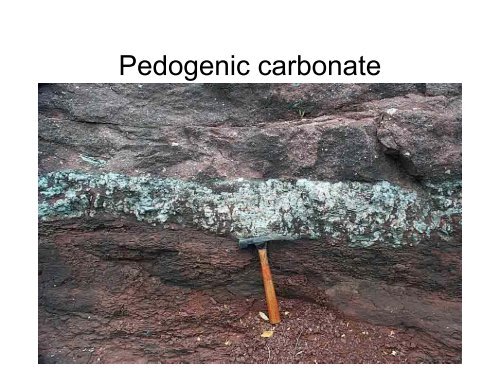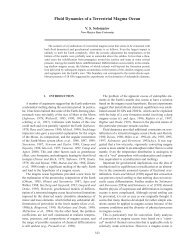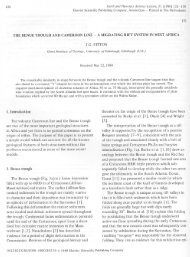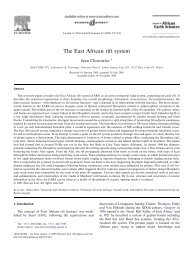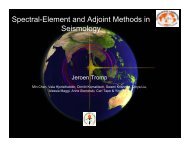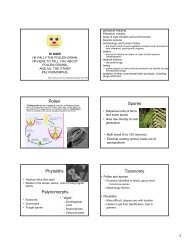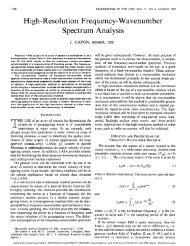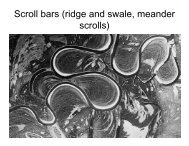Pedogenic carbonate
Pedogenic carbonate
Pedogenic carbonate
You also want an ePaper? Increase the reach of your titles
YUMPU automatically turns print PDFs into web optimized ePapers that Google loves.
<strong>Pedogenic</strong> <strong>carbonate</strong>
Formation of calcic horizons<br />
• Requires dry climate<br />
– Rain=leaching=acid=<strong>carbonate</strong> soluble<br />
• In US, most soils west of prairie-forest<br />
transition (not mountains) have <strong>carbonate</strong>
Depth to <strong>carbonate</strong> horizon<br />
• Carbonate comes from…<br />
– Ca: dust (windblown)<br />
– C- decomposition of organic<br />
matter/atm/resp<br />
• Soluble, so depth is a<br />
function of rainfall…<br />
– Reported relationship<br />
• Depth to top of calcic horizon<br />
correlated to MAP<br />
• R2=.62, stdev=149mm<br />
• Reanalysis, more data r2=0.31
Other problems<br />
• Modern relationship masks control of atm CO2<br />
(also correlated to depth!)<br />
• What if it’s truncated?<br />
• What if it’s compacted?<br />
• Mississippi floodplain soils<br />
– Carbonate formed by upward (capillary) movement of<br />
groundwater; depth reflects water table…<br />
– Retallack equation calculates 545 and 908 mm, actual<br />
1500<br />
• Used rather extensively…
Isotopes…<br />
• C from OM/CaCO3<br />
• O from CaCO3<br />
• Check- offset in C<br />
right?<br />
• C-veg. or ?<br />
• O…rain?
Atmospheric CO2?<br />
• “Paleosol barometer”<br />
– 2 component mixing: atmospheric and soil CO2<br />
– Ca is atmospheric CO2 concentration (ppmV), Sz is<br />
soil-respired CO2 concentration (ppmV), and<br />
δ13Cs, δ13Cr, and δ13Ca are isotopic<br />
compositions of soil CO2, soil-respired CO2, and<br />
atmospheric CO2, respectively.<br />
• Cerling, T.E., 1999, Stable carbon isotopes in paleosol <strong>carbonate</strong>s, in Thiry, M., and Simon-Coincon, R., eds.,<br />
Palaeoweathering, palaeosurfaces and related continental deposits: International Association of<br />
Sedimentologists Special Publication 27, p. 43–60.
Where to get variables?<br />
• No, or known C4<br />
• Atmospheric d13C?<br />
– Find marine rocks of similar age.<br />
– Find shallow-living microfossils making shells from<br />
<strong>carbonate</strong><br />
– Assume equilibrium between dissolved CO2 in ocean<br />
and atmosphere<br />
–Calculate<br />
• Soil respired carbon d13C<br />
– Measure from OM? Find nearby coals?<br />
• Soil respired C concentration<br />
– Estimate from modern analogue<br />
• Soil CO2- measure from pedogenic <strong>carbonate</strong>…
Or…<br />
• Estimate a simpler relationship from<br />
different soil types
Other?<br />
• Total Fe content of Fe-Mn nodules in<br />
vertisols correlates to MAP (r2=.92)<br />
– Not dependent on soil depth! (better than<br />
<strong>carbonate</strong>!)<br />
• Oxygen/hydrogen isotopes of sheet<br />
silicates…(?)<br />
– Must be authigenic (formed in soil)
Or…<br />
• Estimate a simpler relationship from<br />
different soil types
Depth to <strong>carbonate</strong> horizon<br />
• Carbonate comes from…<br />
– Ca: dust (windblown)<br />
– C- decomposition of organic<br />
matter, respiration, atm. Etc.<br />
• identified using 10% HCl<br />
– degree of effervescence<br />
(audible only, visible as<br />
individual bubbles, or foamlike)<br />
• Depth is a function of<br />
rainfall…<br />
– Tied to pCO2, evap
For what soils does this work??<br />
• Soils of “moderate development”<br />
– Carbonate “nodules”, not “wisps” or “layers”<br />
• Unconsolidated parent material<br />
• Seasonal warm climates *if*<br />
– Depth measured to “abundant” not “solitary”<br />
nodules<br />
– *and* “within the low points of gilgai<br />
microrelief”
Gilgai microrelief<br />
• Gilgai: Australian aboriginal term for small<br />
water hole<br />
• Usually associated with vertisols/shrink<br />
swell
Does not work for…<br />
• “Petrocalcic horizons”<br />
• Calcretized bedrock<br />
• Dolocretes<br />
• Carbonate collars<br />
• Erosion-susceptible hillslope soils<br />
• “Nevertheless, the relationship…has<br />
wided applicability to soils of tropical to<br />
frigid, monsoonal to mildly seasonal, and<br />
desert to forest climates”
Other precipitation indicators<br />
• In general;<br />
wetter=more<br />
clay, more red,<br />
less weatherable<br />
stuff<br />
• Histosols=wet<br />
• Aridisols=dry<br />
– evaporites
Clays<br />
• Clays: Hydrated layer silicates<br />
of Al, Fe, and Mg<br />
• Weathering products:<br />
authigenic (formed in soil)<br />
– Aluminum/octahedral,<br />
silica/tetrahedral<br />
– 1:1 group (TO; kaolinite)<br />
• CEC low<br />
– 2:1 groups (TOT)<br />
• smectite (montmorillonite)<br />
– CEC high, shrink/swell<br />
• Mica (illite)<br />
– CEC low; inter unit cations<br />
– 2:1:1 group ((TOT)O;chlorite)<br />
• 2:1 plus octahedral, CEC<br />
moderate-low<br />
– Mixed layer clays
Clays vs. climate and time<br />
• Weathering extent <br />
sequence of clays<br />
– Muscovite/illite/chlorite<br />
–Smectites<br />
– Kaolinite<br />
– Oxides<br />
• Depends on other soil-forming<br />
factors<br />
– Grain size/mineral composition<br />
of parent<br />
– Temperature, seasonality of<br />
rainfall, time
• Palygorskite, Sepiolite<br />
Indicator clays<br />
– Very dry (Morocco: all clays in soils
• Kaolinite (clay), boehmite, gibbsite<br />
(aluminum oxides)<br />
– Very humid<br />
– (tropics)
How to use?<br />
• Ideally, use soils developed on igneous or<br />
metamorphic bedrock<br />
• Petrographic work<br />
– “Bright clay fabric” = soil clays vs. alluvial clays<br />
• Grain size<br />
– Authigenic finer grained<br />
• Crystallinity (XRD)<br />
– More finely crystalline= authigenic<br />
• Also check for burial alteration<br />
– “Illitization”<br />
– Lots of paleosols=illite dominant<br />
– Alteration of smectite to illite during burial?
Burial illitization<br />
• Not necessarily complete!<br />
– Smectite often left<br />
– Illitization spatially limited<br />
• Check:<br />
• (Maybe you’re ok)<br />
– Crystallinity<br />
• “metamorphic” illite= more crystalline<br />
– Chemical variation<br />
• Long story:<br />
– Coupled variations in Na/Ca/Al/K different for weathering<br />
process vs. illitization
Soil chemistry<br />
• Idea: more water, fewer bases<br />
• Won’t work for:<br />
– Dry climate soils (evaporites)<br />
– Wet climate soils (lots of kaolinite clay; Al<br />
only, can’t change)<br />
– Very weakly developed<br />
– Very strongly developed<br />
– Altered by burial illitization
• Clays!<br />
Oxygen/hydrogen isotopes<br />
– Must be authigenic (formed in soil)<br />
– Temperature dependent fractionation- water to<br />
clay<br />
– Unknown water<br />
– Possibility for post depositional alteration by<br />
hydrothermal fluids<br />
• Seems to work?
• Total Fe content of Fe-Mn nodules in<br />
vertisols correlates to MAP (r2=.92)<br />
– Not dependent on soil depth! (better than<br />
<strong>carbonate</strong>!)<br />
Geology: Vol. 29,<br />
No. 10, pp. 943–946.<br />
<strong>Pedogenic</strong> ironmanganese<br />
nodules<br />
in Vertisols: A new<br />
proxy for<br />
paleoprecipitation?<br />
Cynthia A. Stiles, *<br />
Claudia I. Mora, and<br />
Steven G. Driese


